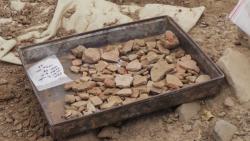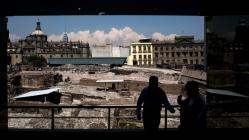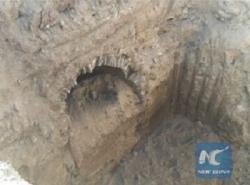INSTITUT SUPERIEUR D'ANTHROPOLOGIE
INSTITUTE OF ANTHROPOLOGY
ONLINE COURSES / COURS A DISTANCE
WINTER TERM : JANUARY 2016
REGISTER NOW
BOLIVIE –  La Paz - A group of Bolivian archaeologists have been camped out in the center of La Paz ever since rare pieces of pottery and ceramics were discovered from thousands of years ago. “These fragments and other utensils date back to the Tiwanaku people who arrived in this area 2,500 years B.C.,” archaeologist Carlos Lemus, who is part of the team working at the site in the neighborhood of Miraflores in La Paz, told teleSUR. “We have only just started our work but the artifacts date back to the arrival in La Paz of the first farmers who came from Tiwanaku,” Lemus said. The famed Tiwanaku culture is an ancient Bolivian civilization located near Lake Titicaca and built 4,000-meters above sea level. Builders stumbled across the rare pieces of broken pottery from this era during the construction of a new cable car station in the center of La Paz. Experts said the ceramic pieces of pre-Columbian pottery and utensils were used by a community of Tiwanku members who settled in Miraflores in La Paz. Such pieces have not been found in an urban setting in Bolivia for years.
La Paz - A group of Bolivian archaeologists have been camped out in the center of La Paz ever since rare pieces of pottery and ceramics were discovered from thousands of years ago. “These fragments and other utensils date back to the Tiwanaku people who arrived in this area 2,500 years B.C.,” archaeologist Carlos Lemus, who is part of the team working at the site in the neighborhood of Miraflores in La Paz, told teleSUR. “We have only just started our work but the artifacts date back to the arrival in La Paz of the first farmers who came from Tiwanaku,” Lemus said. The famed Tiwanaku culture is an ancient Bolivian civilization located near Lake Titicaca and built 4,000-meters above sea level. Builders stumbled across the rare pieces of broken pottery from this era during the construction of a new cable car station in the center of La Paz. Experts said the ceramic pieces of pre-Columbian pottery and utensils were used by a community of Tiwanku members who settled in Miraflores in La Paz. Such pieces have not been found in an urban setting in Bolivia for years.
http://www.telesurtv.net/english/news/Bolivian-Archaeologists-Dig-For-Rare-Artefacts-20151130-0030.html?
ITALIE –  Agrigente - An ancient Greek temple was built to face the setting full moon near the winter solstice, according to new research that sheds new light on the orientation of sacred monuments. A new survey of the Valley of the Temples just outside Agrigento, Italy, reveals the 2,500-year-old temples were not deliberately aligned to the rising sun, as generally believed. A variety of factors, not all of them being astronomical, inspired the ancient architects. “Alignment was widely determined by urban layout and morphological aspects of the terrain as well as religious connections,” Giulio Magli, professor of archaeoastronomy at Milan’s Polytechnic University, told Discovery News. Known as the temple of Demeter and Persephone, the shrine is among a World Heritage-listed collection of temples that once stood in full glory in Akragas, later to be called Agrigento.Akragas was one of the most important Greek colonies in Sicily, and the homeland of the philosopher Empedocles (490–430 BC). Empedocles was the first to divide matter into the four elements of earth, fire, water and air. He also observed that the moon shines with light reflected from the sun. Findings are published on the Cornell University physics Web site, arXiv.org.
Agrigente - An ancient Greek temple was built to face the setting full moon near the winter solstice, according to new research that sheds new light on the orientation of sacred monuments. A new survey of the Valley of the Temples just outside Agrigento, Italy, reveals the 2,500-year-old temples were not deliberately aligned to the rising sun, as generally believed. A variety of factors, not all of them being astronomical, inspired the ancient architects. “Alignment was widely determined by urban layout and morphological aspects of the terrain as well as religious connections,” Giulio Magli, professor of archaeoastronomy at Milan’s Polytechnic University, told Discovery News. Known as the temple of Demeter and Persephone, the shrine is among a World Heritage-listed collection of temples that once stood in full glory in Akragas, later to be called Agrigento.Akragas was one of the most important Greek colonies in Sicily, and the homeland of the philosopher Empedocles (490–430 BC). Empedocles was the first to divide matter into the four elements of earth, fire, water and air. He also observed that the moon shines with light reflected from the sun. Findings are published on the Cornell University physics Web site, arXiv.org.
http://news.discovery.com/history/archaeology/ancient-greek-temple-aligned-to-full-moon-151130.htm
MEXIQUE –  Mexico - Archaeologists have found a tunnel-like passageway that apparently leads to two sealed chambers in Mexico's Templo Mayor complex. It is the latest chapter in the search for the as-yet-undiscovered tomb of an Aztec ruler. The Aztecs are believed to have cremated the remains of their leaders during their 1325-1521 rule, but the final resting place of the remains has never been found. Government archaeologist Leonardo Lopez Lujan says the 27ft- long tunnel was found leading into the centre of a circular platform where dead rulers were cremated. The mouth of the tunnel was sealed by a three-ton slab of rock, with offerings underneath. At the end of the tunnel, archaeologists can see two sealed entrances. Outside experts said the find would be significant.
Mexico - Archaeologists have found a tunnel-like passageway that apparently leads to two sealed chambers in Mexico's Templo Mayor complex. It is the latest chapter in the search for the as-yet-undiscovered tomb of an Aztec ruler. The Aztecs are believed to have cremated the remains of their leaders during their 1325-1521 rule, but the final resting place of the remains has never been found. Government archaeologist Leonardo Lopez Lujan says the 27ft- long tunnel was found leading into the centre of a circular platform where dead rulers were cremated. The mouth of the tunnel was sealed by a three-ton slab of rock, with offerings underneath. At the end of the tunnel, archaeologists can see two sealed entrances. Outside experts said the find would be significant.
http://www.independent.ie/world-news/americas/tunnel-may-lead-to-aztec-rulers-undiscovered-tomb-archaeologists-say-34250254.html?
COREE –  Kaesong- South and North Korean archaeologists discovered what may be movable metal type made before 1361 at the site of a royal palace from the Goryeo Dynasty (918-1392) in what is today Kaesong, North Korea. If the type is indeed from that era, it precedes the Gutenberg Bible - the first book printed in Western Europe using movable metal type - by more than a century. The Gutenberg Bible was printed in 1455. It would be the third example of Goryeo-era metal type found in the Korean Peninsula. Although there are historical records that movable type was being used in Korea beginning in the early 1200s, there are only two pieces of Goryeo-era movable type in South and North Korea - one in Pyongyang’s Chosun Central Historical Museum and the other in the Seoul’s National Museum of Korea. And while there is one surviving volume of “Jikji Simche Yojeol,” a book containing the essentials of Zen Buddhism printed in Korea in 1377 and the oldest extant book printed using movable metal type, the type used to print the book has not been found. Announcing on Monday the results of the six-month archaeological exploration at the site of the royal palace in Kaesong - known as Manwoldae - the Inter-Korean Historian Association said it found the movable type on Nov. 14. “Based on reviews by experts, we believe the movable type is indeed from the Goryeo period,” Choe Kwang-shik, the head of the association, told reporters. “And given that Manwoldae was destroyed in 1361, we think chances are high that the piece is from before that year.” The association added that the movable type - 1.36 centimeters (0.54 inches) wide, 1.3 centimeters long and 0.6 centimeters thick - displays a sophisticated calligraphy style and advanced casting technology, compared with the previously discovered pieces of type. Based on this, Korean scholars believe that the movable type found at Manwoldae was most likely part of a project led by the royal court of the Goryeo Dynasty. The printing of “Jikji Simche Yojeol,” on the other hand, was led by the Buddhist leadership.
Kaesong- South and North Korean archaeologists discovered what may be movable metal type made before 1361 at the site of a royal palace from the Goryeo Dynasty (918-1392) in what is today Kaesong, North Korea. If the type is indeed from that era, it precedes the Gutenberg Bible - the first book printed in Western Europe using movable metal type - by more than a century. The Gutenberg Bible was printed in 1455. It would be the third example of Goryeo-era metal type found in the Korean Peninsula. Although there are historical records that movable type was being used in Korea beginning in the early 1200s, there are only two pieces of Goryeo-era movable type in South and North Korea - one in Pyongyang’s Chosun Central Historical Museum and the other in the Seoul’s National Museum of Korea. And while there is one surviving volume of “Jikji Simche Yojeol,” a book containing the essentials of Zen Buddhism printed in Korea in 1377 and the oldest extant book printed using movable metal type, the type used to print the book has not been found. Announcing on Monday the results of the six-month archaeological exploration at the site of the royal palace in Kaesong - known as Manwoldae - the Inter-Korean Historian Association said it found the movable type on Nov. 14. “Based on reviews by experts, we believe the movable type is indeed from the Goryeo period,” Choe Kwang-shik, the head of the association, told reporters. “And given that Manwoldae was destroyed in 1361, we think chances are high that the piece is from before that year.” The association added that the movable type - 1.36 centimeters (0.54 inches) wide, 1.3 centimeters long and 0.6 centimeters thick - displays a sophisticated calligraphy style and advanced casting technology, compared with the previously discovered pieces of type. Based on this, Korean scholars believe that the movable type found at Manwoldae was most likely part of a project led by the royal court of the Goryeo Dynasty. The printing of “Jikji Simche Yojeol,” on the other hand, was led by the Buddhist leadership.
http://koreajoongangdaily.joins.com/news/article/Article.aspx?aid=3012241
CHINE - Ningxia - More than 300 items used by prehistoric people in daily life 4,000 years ago were unearthed in Northwest China's Ningxia Hui Autonomous Region. Wang Xiaoyang, head of the archaeological team that made the discoveries, said on Monday that the pieces were found at an 800-square-meter excavation area at the Beiyuan relic site. The artifacts include clay pots, basins, cups and knives, stone axes and chisels, as well as bone awls and needles. Archaeologists also found clamshells which they believe were used for decoration. The Beiyuan site, which covers 25,000 square meters, was first excavated in 2013. This year about 40 people led by the Ningxia Regional Archaeological Institute conducted a second excavation to learn more about the Neolithic culture and development of the region. Experts searched 11 houses - one cave dwelling and 10 kivas - 151 pits, three kilns and a tomb. The kivas were square in shape with a round cooking range at the center and were painted white with lime.
http://www.globaltimes.cn/content/955835.shtml?
CHINE –  Datong Hui - A tomb dating back some 2,000 years has been found in northwest China's Qinghai Province, local authorities said Thursday. The tomb was discovered by a construction team on Nov. 23 in a village of Datong Hui and Tu Autonomous County, according to Chen Rong, deputy head of the county's cultural relic management bureau. The occupant of the tomb was confirmed as a male around 50 years old. Alongside this complete skull, cultural workers also found bricks and pottery that date the tomb to the Han Dynasty (206 BC - 220). Chen said, it was the tomb of a rich man, but his identity remains unknown. He added that the eastern Qinghai, where Datong is located, is an important gateway linking China's inland and western regions, so further excavation and confirmation of the occupant's identity will contribute to the study of cultural exchange between the two areas during the Han Dynasty.
Datong Hui - A tomb dating back some 2,000 years has been found in northwest China's Qinghai Province, local authorities said Thursday. The tomb was discovered by a construction team on Nov. 23 in a village of Datong Hui and Tu Autonomous County, according to Chen Rong, deputy head of the county's cultural relic management bureau. The occupant of the tomb was confirmed as a male around 50 years old. Alongside this complete skull, cultural workers also found bricks and pottery that date the tomb to the Han Dynasty (206 BC - 220). Chen said, it was the tomb of a rich man, but his identity remains unknown. He added that the eastern Qinghai, where Datong is located, is an important gateway linking China's inland and western regions, so further excavation and confirmation of the occupant's identity will contribute to the study of cultural exchange between the two areas during the Han Dynasty.
http://www.xinhuanet.com/